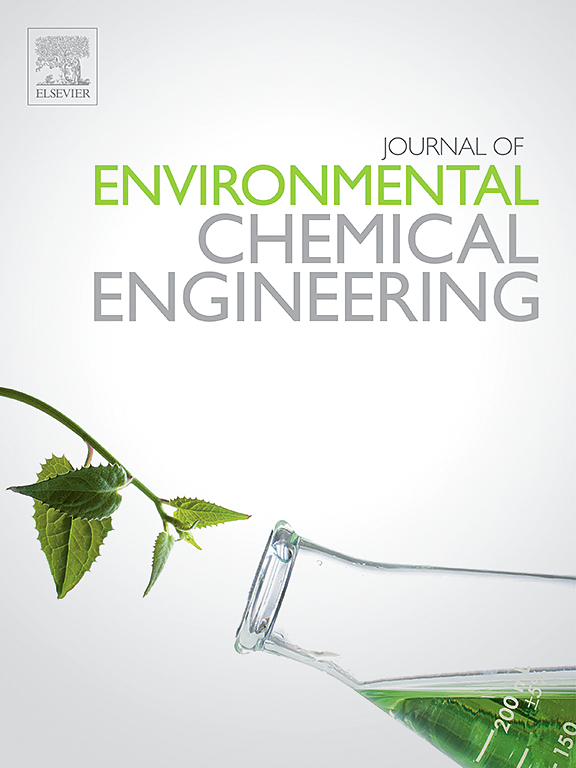A novel amidoxime-functionalized covalent organic framework adsorbent for efficient lead ion removal: Synthesis and adsorption mechanism
IF 7.4
2区 工程技术
Q1 ENGINEERING, CHEMICAL
引用次数: 0
Abstract
Lead ions are highly toxic heavy metal ions and Pb(II) in wastewater threatened seriously human health and environment. Therefore, an effective adsorbent must be developed to remove lead ions from wastewater. In this study, a polycrystalline amidoxime covalent organic framework (DBCC-NHOH) is synthesized by a post-modification method for the elimination of Pb(II) from wastewater. The successful preparation of adsorbent (DBCC-NHOH) is demonstrated by the oxygen appearance in SEM-EDS pattern and conversion of -C≡N to C=N-O and C-N in the FT-IR pattern. DBCC-NHOH is a crystalline porous material and its pore size, specific surface area and pore volume are 3.419 nm, 28.154 m2/g and 4.2ⅹ10−8 m3/g respectively. The optimum conditions for the adsorption of Pb(II) by DBCC-NHOH are temperature 298 K, time 180 min, and pH 5. The maximum adsorption of DBCC-NHOH was 221.37 mg/g. Kinetic and thermodynamic investigations indicate that adsorption of Pb(II) by DBCC-NHOH is a monolayer chemisorption and exothermic process. Selectivity experiments indicate that DBCC-NHOH can adsorb Pb(II) efficiently and selectively in complex multi-ion systems. In addition, the adsorption percentage of DBCC-NHOH remained up to 83.20 % after five adsorption-desorption experiments. The XPS and FT-IR analyses and DFT results indicated that DBCC-NHOH utilized amidoxime function group to realize the high efficiency of Pb(II) adsorption by electrostatic attraction and chelation.
一种用于高效去除铅离子的新型脒肟功能化共价有机框架吸附剂:合成与吸附机理
铅离子是剧毒重金属离子,废水中的铅(II)严重威胁人类健康和环境。因此,必须开发一种有效的吸附剂来去除废水中的铅离子。本研究采用后改性方法合成了一种多晶脒肟共价有机框架(DBCC-NHOH),用于去除废水中的铅(II)。吸附剂(DBCC-NHOH)的成功制备表现在 SEM-EDS 图谱中出现了氧,FT-IR 图谱中 -C≡N 转化为 C=N-O 和 C-N。DBCC-NHOH 是一种结晶多孔材料,其孔径、比表面积和孔体积分别为 3.419 nm、28.154 m2/g 和 4.2ⅹ10-8 m3/g。DBCC-NHOH 吸附铅(II)的最佳条件为温度 298 K、时间 180 分钟、pH 值 5。动力学和热力学研究表明,DBCC-NHOH 对铅(II)的吸附是一个单层化学吸附和放热过程。选择性实验表明,DBCC-NHOH 能在复杂的多离子体系中高效、选择性地吸附铅(II)。此外,经过五次吸附-解吸实验后,DBCC-NHOH 的吸附率仍高达 83.20%。XPS和FT-IR分析以及DFT结果表明,DBCC-NHOH利用脒肟功能基团,通过静电吸引和螯合作用实现了对铅(II)的高效吸附。
本文章由计算机程序翻译,如有差异,请以英文原文为准。
求助全文
约1分钟内获得全文
求助全文
来源期刊

Journal of Environmental Chemical Engineering
Environmental Science-Pollution
CiteScore
11.40
自引率
6.50%
发文量
2017
审稿时长
27 days
期刊介绍:
The Journal of Environmental Chemical Engineering (JECE) serves as a platform for the dissemination of original and innovative research focusing on the advancement of environmentally-friendly, sustainable technologies. JECE emphasizes the transition towards a carbon-neutral circular economy and a self-sufficient bio-based economy. Topics covered include soil, water, wastewater, and air decontamination; pollution monitoring, prevention, and control; advanced analytics, sensors, impact and risk assessment methodologies in environmental chemical engineering; resource recovery (water, nutrients, materials, energy); industrial ecology; valorization of waste streams; waste management (including e-waste); climate-water-energy-food nexus; novel materials for environmental, chemical, and energy applications; sustainability and environmental safety; water digitalization, water data science, and machine learning; process integration and intensification; recent developments in green chemistry for synthesis, catalysis, and energy; and original research on contaminants of emerging concern, persistent chemicals, and priority substances, including microplastics, nanoplastics, nanomaterials, micropollutants, antimicrobial resistance genes, and emerging pathogens (viruses, bacteria, parasites) of environmental significance.
 求助内容:
求助内容: 应助结果提醒方式:
应助结果提醒方式:


